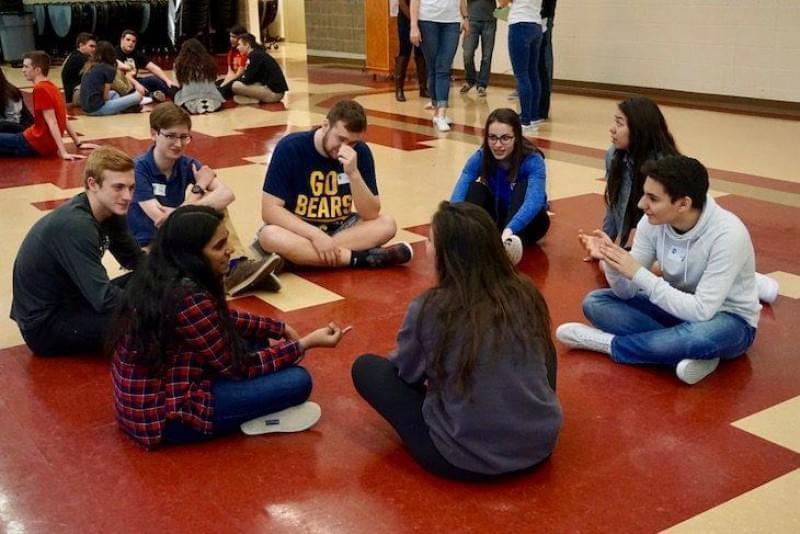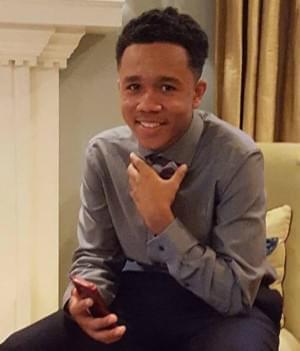Illinois Issues: New School Discipline Philosophy One Year Later

Out-of-school suspensions have dropped from roughly 700 per year to about 50 since Principal Chad Adams established a Peace Room at Sullivan High School in Chicago. Dusty Rhodes/NPR Illinois
School districts had a year to implement a state law that banned zero-tolerance policies and emphasized restorative justice practices. We check back in with five districts we visited in the summer of 2016 to see how school discipline has changed.
On the second day of the school year, Amber Owens got the kind of jolt every parent dreads. She was called to the nurse’s office at Champaign’s Bottenfield Elementary, where she found her 7-year-old son, Simon, sobbing uncontrollably and bleeding from the mouth. He had been punched in the face during recess by another second-grade student.
She got him calmed down enough to allow her to check his permanent teeth. They seemed a little wiggly, so Owens phoned her husband to come get Simon so he could be checked out by the dentist. As they waited, a school administrator stepped into the nurse’s office, bringing with her the boy who had punched Owens’ son.
Face-to-face, the puncher apologized. Then the administrator asked the puncher: “How is Simon going to know this isn’t going to happen again?” The puncher promised them all that it wouldn’t.
“Which I really appreciated,” Owens says, “because I think that anxiety after you've been hurt by someone — whether it be words or by physical violence — I think that's a real emotion that kids carry around.”
But as far as she knows, that conversation may have been the puncher’s only punishment.
“He wasn't suspended. I didn't ask about any other consequences, because, you know, it's not really my business,” she says. “But I was okay with that — that restorative conversation. That was enough for me as a parent.”
Owens isn’t just a parent, however; she also happens to be the music teacher at Bottenfield Elementary, which means she knew the puncher. He was one of her students.
“And as a teacher,” she says, “what I really wanted to happen next was to get that child back into my classroom, so that we could get him to a happier place, so that he could let go of some of the anger that he's bringing in with him every day to school.”
Aside from the fact that Simon’s teeth were fine, this story doesn’t have a clear happy ending. Owens didn’t get much chance to intervene with the angry puncher because, a few weeks after this incident, his family moved to a different district. But if this same incident had occurred as recently as a couple of years ago, it would have played out quite differently. The puncher wouldn’t have had to confront Simon’s bloody face or apologize; instead, he would’ve likely been suspended for several days, after which he would return to school running behind in his class work and still angry.
This new philosophy of school discipline stems from a new state law designed to make exclusionary discipline, out-of-school suspensions and expulsions, the punishment of last resort. Known among educators as Senate Bill 100, the law limits such harsh discipline to cases where a student’s continued presence in school would pose a safety threat or substantially disrupt school operations. The law also requires school administrators to show they’ve tried other behavioral interventions before forcing a student to miss school.
When legislators passed the law in 2015, they realized some districts would basically need a heart transplant, so they built in a one-year preparation period. SB 100, now Public Act 99-456, took effect in September 2016, and statewide data is already showing the effects. According to annual reports published by the Illinois State Board of Education, expulsions without services (the harshest discipline) decreased by more than 28 percent, and out-of-school suspensions fell by 21 percent compared to the 2015-16 school year.
We visited five different school districts in the summer of 2016, to see how they were preparing to implement the new law. Now that they’ve tried it for a year, we decided to check back in.
Batavia: De-escalation And Mindfulness Work
The year before SB 100 was adopted, Batavia schools had 119 out-of-school suspensions. After it was adopted, that number was cut to 68.
Amy Biancheri, who teaches high school English, says that’s because the union, the district and the community teamed up to provide “tons” of training and professional development for Batavia teachers.
Much of it focused on adverse childhood experiences (ACEs) like divorce, abuse, neglect or losing a loved one, which can affect a child’s brain chemistry. Because Batavia is an upper-middle-class Chicago suburb, that notion met with some initial skepticism.
“It's kind of a misconception, I think, to say, like, ‘Oh, you're just supposed to be nice and let the kids do whatever they want.’ That's not it at all,” Biancheri says. “But what you do have to do is teach them some skills with regulation, and you need to approach discipline in a different way.”
Their training included materials from Harvard’s Center on the Developing Child, showing that children constantly subjected to trauma or bullying often develop “fight or flight” tendencies that make them overreact to normal stimuli.
“So what you have to do is teach kids who are perceiving their world that way to figure out how to actually slow down, calm down and ask themselves: Is this like some huge scary threat? Or is this your teacher asking you to turn in your homework that you didn't do?”
Biancheri says even teachers who were afraid it was “too touchy-feely” were persuaded by the brain science — plus the immediate results.
“De-escalation actually works. Mindfulness actually works. Having kids be able to self-regulate and calm themselves down when they get worked up — that works,” she says. “Unless it's a child who has some real, real severe issues, those things work on people, and not just people with ACEs.”
Batavia teachers have also been trained in restorative practices, a philosophy of repairing harm after an offense that’s kept discipline issues from spiraling out of control.
“If you have a culture of that in your school, and people who are trained to sort of look at things like that, then that helps,” she says. “It all kind of snowballs in a good way, as opposed to snow-balling in a negative way.”

Batavia High School students play a game during the Link Crew program, which allows juniors and seniors to support incoming freshmen classes. School administrators say community-building programs like Link help "create a positive school environment and (promotes)school safety."
How much did all this training cost? Much of it was free. Biancheri says they surveyed teachers to see what expertise they had, and got de-escalation training from the teachers who specialize in educating students with behavior disorders. The district’s foundation provided a grant to purchase yoga equipment, and a local hospital and some mental health professionals provided training at no cost.
Sullivan: Breaking The Trauma Cycle
Sullivan High School is on Chicago’s north side in the Rogers Park neighborhood, and on paper, it may not look like a great school. Almost one-third of its students are in special education. All but 3 percent are on free and reduced lunch. About 40 percent are learning English. About 300 are immigrants, mostly refugees, speaking Swahili, Urdu, Malay, Arabic or Nepali. It was the topic of a recent Chicago magazine story, describing it as the most diverse school in the city.
But Sullivan has attributes that can’t be captured on paper. There are metal detectors at the entrance, but once inside the school, the vibe is colorful and comfortable. The dress code is basically: Wear a Sullivan shirt, so the staff knows you belong there, and whatever else, except leggings, is fine.

Students at Sullivan High School in Chicago can use the school's Peace Room to resolve conflicts or de-stress. Teachers use it occasionally too to work out office politics.
It wasn’t always this way. When Chad Adams took over as principal in 2013, Sullivan was known for gang fights.
“In 2012 you know we had over 700 suspensions at a school of, at that time, around 800 kids,” he says.
That was because, in part, a big chunk of the student body was made up of older students with very few credits who would show up occasionally just to cause trouble. Adams purged them from Sullivan, transferring those students to alternative schools.
But another reason those numbers were so high was Chicago Public Schools’ zero-tolerance policies, requiring long out-of-school suspensions for a variety of offenses. CPS officials eventually realized those policies were connected to their low graduation/high dropout rates, and — in a move that predicted SB 100’s statewide mandate — replaced zero-tolerance with a more restorative discipline policy.
Adams was an early and enthusiastic adopter. One of the first changes he made at Sullivan was setting up a “Peace Room.”
Back then, a kid typically got sent to the Peace Room for “a fight or a gang issue or a family-to-family issue,” Adams says. “We started having restorative conversations with kids, and de-escalating kids when they got upset and put them back in class.” The days of hosting large groups in conflict are fading, but kids still come in to resolve social media drama. Teachers come in with students when “they need some space and a mediator to come and sort of reset themselves, refocus the learning,” Adams says.
Brielle Siskin, a social worker, is in charge of Sullivan’s Peace Room. She keeps it stocked with Play-Doh, crayons and a Mancala board — things that can help a teen calm down or ease into a restorative conversation.
“I try to make sure I'm always hearing their side of the story. That's the most important thing with restorative justice is to understand their side of the story,” Siskin says.
From there, she moves on: How are you feeling about it? How may your teacher be feeling about it? Or other classmates affected in this situation? What do we need to do to repair the harm, so we can have you go back into class, and not have further conflict?
“Sometimes, it's a conversation and the student gets returned to class,” Siskin says. “However, often my goal is to bring the student and the teacher or the other student they had a conflict with together to have a conversation to really resolve the issue and talk about it so that it doesn't happen again.”

Social worker Brielle Siskin runs Sullivan High School's Peace Room. Students sometimes let go of grudges by writing on a leaf and taping it to the "forgiveness tree" outside her door.
That last part — “so it doesn’t happen again” — holds the power to permanently transform the culture of a school, given time. At Sullivan, there’s still a few student conflicts, but these days, Siskin spends much of her time in classrooms facilitating community-building circles. The Peace Room hosts occasional restorative circle for staff wanting to work through office politics, and students who self-refer to check in with Suskin. Sullivan High no longer even has an in-house suspension room. Out-of-school suspensions have fallen from around 700 in 2012 to about 50 last year, Adams says.
He believes the restorative philosophy has become the norm in CPS, as principals are moving past the punitive model they themselves grew up with because they understand it didn’t work.
“There's so much trauma in this world, with our children, that we need to be there for them because we don't want trauma to continue,” he says. “The trauma cycle is a scary one. It perpetuates itself, and the only way I believe that you break it as you talk about it.”
Champaign: 'Because Wouldn't You Do That With Your Own Child?'
Orlando Thomas’ official title is director of achievement and student services, which tells you something about Champaign schools. Most anywhere else, Thomas’s title would be dean of discipline. But Champaign reframed it: Thomas’ ultimate goal is to help students succeed; good behavior is just an essential element.
Senate Bill 100 barely blipped his radar. He had already developed district-wide programs to provide social-emotional instruction, intervene with eighth graders at risk for struggling in high school, and help kids who got suspended return to school with improved social skills plus caught up on classwork.
The biggest change Unit 4 made in response to SB 100: “No more mandatory minimum (suspensions),” Thomas said. “All of our language reads ‘up to’ for any and all offenses. So, if a principal wants to mitigate something, an expellable offense, they need to share exactly why they’re choosing to mitigate that… and then we have a group that either approves or provides some guidance to the administrator.”

Orlando Thomas is the director of achievement and student services for Champaign schools, where he constantly reminds teachers that a student's behavior is just the tip of the iceberg of how they're feeling, and they should take time to form deeper relationships.
The school board also decided no student would get more than a three-day suspension unless the administration was pursuing expulsion. And Thomas came up with a way to cut down on those. He helped develop a one-page questionnaire (PDF) that a handful of educators have to fill out 24 hours after a student is found to have committed a possibly expellable offense. The questionnaire prompts administrators to rate the offense by 11 objective metrics, for example, potential threat to safety of others, impact on school climate and number of previous major incidents linked to student, to avoid making rash discipline decisions.
“Because an expulsion for a student is life-changing,” Thomas says, “whether it’s for a semester or one year or the maximum, two years, it is a life-changing event. And as a district, we want to make sure that the incident matches what we’re recommending.”
Champaign’s discipline stats are trending in the right direction. But Amber Owens, the teacher whose son got punched in the mouth, says teachers still need more training, more tools.
“Just because you don't suspend kids for behavior that you would have you know two years ago, five years ago, 10 years ago, doesn't mean that those behaviors aren't happening and doesn't mean that those kids don't need help,” she says.
“So suspending them isn't going to help, but it's also not going to help just to say, ‘Well, now you need to write a letter of apology to the person you yelled at and or, you know, the person you hit or the person you threw to the ground at recess and now it will be fine.’ It's not really going to be fine until they learn how to deal with those emotions and that anger that they're bringing into school.”
Owens’ favorite tool for helping kids is Education Through Music — a concept she’s studied at workshops she paid for on her own.
Another veteran Champaign teacher, Jennifer White, has a different approach to discipline that’s virtually cost-free.
“The way we interact with students now, I almost think is a lot more like we interact with our own children,” White says. “You know, if my son does something disrespectful or that he needs some correction on, I'm going to take time to build our relationship and to teach him those things. And so as we're looking at responding to student behavior now, it is about the student as an entire person, and not just how they are academically in your class.”
Does that mean that a teacher might occasionally have to admit they overreacted, and apologize to a student?
“Oh, absolutely,” White says. “Because wouldn't you do that with your own child?”
Noble Network of Charter Schools: Laser-Focused On Learning
Charter schools often have their own rules: strict dress codes, certain behavior standards. So it’s surprising when, upon entering a Noble campus, there’s no metal detector to scan you.
“We don't do any of that; no metal detectors, no X-ray machines. We just, we want our schools to be warm and welcoming for all kids and for any visitors that come in,” says Cody Rogers, Noble’s director of communications. “We just don't think that that gives off a welcoming feeling and so those always go. But what we can guarantee our parents and our visitors and our students is that in exchange for that, we will have a very structured and supportive environment, so that's how you can accomplish it.”

Students pause in the hallway of Muchin College Prep, a Noble Network charter school.
And he’s not kidding. Rogers gave me a tour of one Noble campus, and every classroom was filled with kids who appeared to be fully engaged in their work.
The Noble Network has 17 high schools in Chicago, and they’re all part of Chicago Public Schools. And although regular schools have discipline data available online, CPS charters do not.
Rogers doesn’t mention concepts like social-emotional learning or trauma-informed teaching; when asked about restorative practices, he agreed they’re in use on Noble campuses. He responded to NPR Illinois’ request for data by reporting that in the first year of SB 100 implementation, the number of suspensions in Noble schools dropped by a remarkable 45 percent.
Each campus has an administrator called a dean of discipline or a dean of culture. Rogers says that dean is tasked with not only discipline, but also identifying students who need extra support. “They'll proactively work with parents and with the school social worker and with other administrators and with the advisor and the teacher, so it goes far beyond just implementing a policy and is much more about keeping the student in class and keeping the learning environment welcoming for all kids,” Rogers says. “What we owe them is a laser focus on teaching and learning.”
Springfield: No Opportunity To Apologize
Isaiah Cooper did something stupid. As he was leaving the school cafeteria one morning, he tossed his milk carton at a door jamb. He played varsity football, but he was a linebacker. His milk carton fell without hitting its target.

Replace this text with your caption
He was in the middle of first hour PE when the school resource officer came and escorted him to office. That milk carton he threw had hit a girl on the head. Isaiah immediately asked for a pen and paper, and began writing her a letter of apology.
An assistant principal called his mom, Lindsay Chisam.
“‘He was just goofing off’ — those were [the assistant vice principal’s] exact words,” Chisam says. “He ‘pulled back his arm and chucked it down the hallway’ is what she says, and she said he didn’t even stick around long enough to see if he’d hit anything.”
The girl’s parents wanted to press charges, so the school resource officer arrested Isaiah for battery, then released him to Chisam’s custody. The assistant principal issued Isaiah a five-day suspension, but increased it to 10 the following day saying the girl suffered a “severe concussion.” When the suspension was over, the Springfield District 186 School Board voted to expel Isaiah for the remainder of his sophomore year plus his entire junior year.
Under new policies created by Senate Bill 100, exclusionary discipline of more than three days could be used only in cases where “the student's continuing presence in school would either (i) pose a threat to the safety of other students, staff, or members of the school community or (ii) substantially disrupt, impede, or interfere with the operation of the school,” and after all other interventions have been exhausted.
District 186 Superintendent Jennifer Gill can’t talk about this case due to privacy laws, but she says all expulsion cases go through a review board that ensures each case conforms to the law before forwarding it to the school board. Isaiah’s case shows that despite the new law, various districts interpret the term “threat” differently.
Gill has data to show that Springfield discipline is headed in the right direction. She points to the grand total of suspension days district-wide — 10,077 the year before SB 100 took effect, compared to 7,643 last year.
“We've had an overall 32 percent decrease,” she says. “In high school alone, it was a 43 percent drop.” Middle school is still a challenge, the numbers have increased slightly, but she recently approved some personnel and scheduling changes designed to continue shifting discipline practices more toward the spirit of SB 100.
“I can't say enough about how it's been a lever. Let's put it that way: It's been a lever to have different types of conversations,” Gill says. “It's been a lever to not do the things that we've always done the way we've always done them … I think it's opened our doors and opened our minds to restorative practice and trauma-informed practices.”
Restorative practice typically involves bringing together the people who have had a conflict, so the perpetrator has to see the harm and perhaps repair the relationship. Springfield schools are starting to implement the concept in certain settings, but it wasn’t offered to Isaiah. It’s been nine months since he injured a girl by throwing a milk carton, but he hasn’t had an opportunity to apologize.
“I would say that I'm sorry, and that I never intentionally meant to hurt anybody, especially a girl … And I’m really sorry if I if I hurt you or messed anything up,” Isaiah says. “And if it embarrassed you, I'm sorry. I'm just sorry for everything.”

The school board reviewed his case after the first quarter of the current school year, and allowed him to re-enroll in school.
Illinois Issues is in-depth reporting and analysis that takes you beyond the headlines to provide a deeper understanding of our state.
Illinois Issues is produced by NPR Illinois in Springfield.
Links
- Illinois Issues: Campaign 2018 - Rauner Vs. Madigan
- Illinois Issues: Third Party Candidates Want Rules Eased To Get On Ballot
- Illinois Issues: Legislative Checklist - Veto Session
- Illinois Issues: Is The State Budget Balanced?
- Illinois Issues: Cities Lose Out On Retail Tax As Online Shopping Booms
- Illinois Issues: Land of Lincoln, New Jersey Compete For Worst Fiscal Condition
- Illinois Issues: Worry About DACA’s Fate Triggers Anxiety, Depression In Immigrants
- Illinois Issues: Coming Up In The Veto Session
- Illinois Issues: We Have Met The Enemy And He Is Us
- Illinois Issues: A Master Of Compromise Exits
- Illinois Issues: The Man With The Education Reform Mission
- Illinois Issues: No Money For Shoes
- Illinois Issues: Flat Vs. Graduated Income Tax
- Illinois Issues: Cairo Faces Public Housing Crisis
- Illinois Issues: ERA — Yesterday And Today
- Illinois Issues: The Experts’ Take On The Budget
- Illinois Issues: The Prairie State’s Nuclear Waste Conundrum
- Illinois Issues: The Battle Over Transparency And Privacy In The Digital Age
- Illinois Issues: Local Icon Shifts To ‘The Most Dangerous Woman In America’
- Illinois Issues: Legislative Checklist

